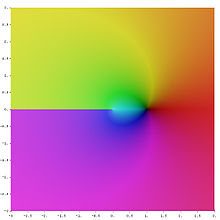Logarithm
The logarithm (plural: logarithms; from the ancient Greek λόγος lógos, "understanding, teaching, ratio", and ἀριθμός, arithmós, "number") of a number is the exponent by which a previously defined number, the base, must be exponentiated to obtain the given number, the numerus. Logarithms are only defined for positive real numbers; the base must also be positive.
The logarithm of a positive real number 










Logarithms can be used to clearly represent very strongly growing series of numbers, since the logarithm for large numbers increases much more slowly than the numbers themselves. As the equation 
Corresponding mathematical calculations have already been handed down from India in the time before the birth of Christ. The term logarithm was coined by John Napier in the early 17th century. In Napier's honour, the natural logarithm (see below) is sometimes also called Napier's logarithm or Neper's logarithm.
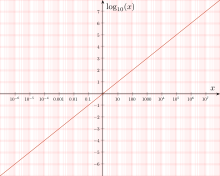
In semi-logarithmic application (in relation to the x-axis), the graph of the logarithm function becomes a straight line. Shown here as an example for the logarithm to the base 10.
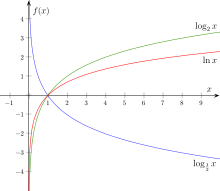
Graph of the logarithm function in base 2 (green), e (red) and 1/2 (blue)
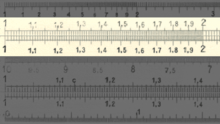
Logarithmic scale division of a slide rule (detail)
Overview
The use of the logarithm can be traced back to Indian antiquity. With the rise of banking and the progress of astronomy in 17th century Europe, the logarithm became increasingly important. Its function values were recorded in tables, the logarithmic tables, in order to be able to look them up and not always have to recalculate them. These tables were eventually replaced by slide rules and later by pocket calculators. The change from tables to slide rules took place in German schools in the 1960s, the change to pocket calculators from the 1970s.
Central aspects of life can be described with the help of logarithms. For example, the strength of a sensory impression increases as a function of a physical quantity such as brightness or volume according to the course of a logarithm function. The same applies to the perceived pitch as a function of the frequency of a tone.
Logarithms acquired their historical significance through the connection
which allows a multiplication to be expressed by an addition.
Formally, logarithms are all solutions 
to given sizes 

Depending on the range of numbers and the quantities for which this equation is considered, it has no solution, several solutions or exactly one solution. If the solution is unique, then it is called the logarithm of 

For example, the logarithm of 8 to the base 2 is equal to 3, written 

If the above equation is to be solved



The best known and most widely used is the logarithm over the positive real numbers, which will be presented primarily in the following.
History
Indian mathematicians in the 2nd century BC were the first to mention logarithms. Even in ancient times, they used logarithms in base 2 for their calculations. In the 8th century, the Indian mathematician Virasena described logarithms in base 3 and 4. From the 13th century onwards, entire logarithmic tables were created by Arab mathematicians.
Nicolas Chuquet clearly worked out the laws of arithmetic for powers 

The German mathematician Michael Stifel formulated similarly in 1544 the relations 

In the 17th century, the Swiss clockmaker Jost Bürgi (1552-1632) developed a new system for calculating logarithms, which he published in 1620 after much work. But even before that, in 1614, the Scottish thinker John Napier published a book on logarithms that made him famous as the "inventor of logarithms". However, Bürgi and Napier developed their work and findings on logarithms independently of each other.
The Greek word "logarithm" means "ratio" and comes from Napier. It is true that 





After the Oxford professor Henry Briggs (1561-1630) had studied this writing intensively, he contacted its author and suggested using the base 10 for the logarithms (abbreviated lg). These spread quickly and were especially appreciated in astronomy, which Pierre-Simon Laplace also noted, in comparison to the trigonometric tables used before:
"L'invention des logarithmes, en réduisant le temps passé aux calculs de quelques mois à quelques jours, double pour ainsi dire la vie des astronomes."
"By reducing the time needed for calculations from a few months to a few days, the invention of logarithms has, so to speak, doubled the lifetime of an astronomer."
If the Euler number 
With the logarithms, the mathematical basis for the further development of the mechanical slide rule was laid; for the functioning of the slide rule is based on the principle of addition and subtraction of logarithms.
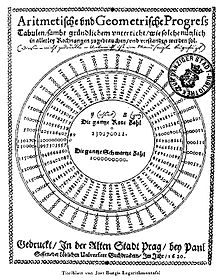
Title page to Jost Bürgi's logarithm table from 1620
Logarithm in application and nature
Applications of the logarithm are often found in science when the range of values covers many orders of magnitude. Data are either represented with a logarithmic scale or logarithmically defined quantities are used, as for example with the pH value or the sensitivity of the sensory organs.
In the living nature
Numerous examples of logarithmic spirals can be found in living nature, such as the growth of snail shells or the arrangement of the seeds on the sunflower.
Sound pressure level
The sound pressure level is used as a logarithmic measure to describe the strength of a sound event. The auxiliary unit of measurement decibel (dB) is used for this purpose.
Brightness perception
A logarithmic evaluation has also proven itself for the sensory perception of brightness (Weber-Fechner law), since the human eye can bridge up to 10.5 powers of ten in physical luminance between twilight and bright sunshine.
pH value
The pH value is the measure of the acidic or basic character of an aqueous solution. Note: In chemistry, logarithmic scales are generally indicated by a preceding p (for power), for example in the pKS or pKB value.
Richter scale
The Richter scale, which is used to describe earthquake magnitudes, is based on a deca-logarithmic division. The earthquake magnitude therefore increases exponentially from level to level.
Star brightnesses
Star magnitudes are given in astronomical magnitude classes, which is a logarithmic measure of the actual radiant intensity.
Slide rule
Before electronic calculators were available, the laws of logarithms were exploited to simplify multiplications into additions and divisions into subtractions. The calculation of the square root is simplified at the level of the logarithm to a division by two. Because the logarithm itself is not so easy to calculate, slide rules with their logarithmic scale divisions and logarithm tables were widely used aids.
Growth and decay processes
Typical tasks in growth and decay processes can be modelled by the inverse function of the logarithm - the exponential function. See Exponential process, Absorption.
Number of digits of a number
Calculate the number of digits needed to represent a natural number in a place value system. To 


For example, is 



Benford's Law
The distribution of the digits of numbers in empirical data sets, for example their first digits, follows a logarithmic distribution, Benford's law.
Information unit
Measurement of the amount of information; information theory says that if something occurs with probability 



Cryptography
The discrete logarithm is considerably more complicated to calculate in finite bodies and elliptic curves defined on them than its inverse function, the discrete exponential function. The latter can therefore be used as a so-called one-way function in cryptography for encryption.
Logarithmic time scales
Logarithmic time scales are found in the history of technology as well as in the geological time scale.
Intervals of music theory
Intervals have an exponential frequency progression. The auditory system, however, perceives them as linear. The proportions are therefore given as logarithms. The octave is divided into 1200 cents (music). Example:
| Interval | Frequency ratio | Size |
| 1 octave | 2 | 1200 cents |
| 2 octaves | 4 | 2400 Cent |
| 3 octaves | 8 | 3600 Cent |
| … | ||
| major third | 5:4 | |
| Fifth | 3:2 | |
Graphical representation of functions
Special mathematical papers are used for the graphical representation of functions, such as single-logarithmic paper or double-logarithmic paper.
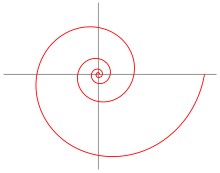
A logarithmic spiral

A slide rule

The shell of a nautilus shows a logarithmic spiral
Designations
One writes for the logarithm of 
and says: " 






For the digits before the decimal point of the logarithm, the term characteristic (sometimes also key figure) is usually used, its digits after the decimal point are called mantissa.
The general mathematical symbol for the logarithm according to DIN 1302. More rarely, one also finds notations deviating from it, such as 
The character 


In addition, special notations are specified for the logarithm in DIN 1302 depending on the application:
Natural logarithm (Latin logarithmus naturalis), the logarithm to base 
Decadic logarithm, also known as the logarithm of ten or Briggs logarithm, the logarithm to the base 10. It is used in numerical calculations in the decimal system.
Binary logarithm, also called logarithm of two, the logarithm to the base 2. It is used in computer science for calculations in the binary system. Outside the standard, 
A similar looking function character is 

Operating elements on a pocket calculator. The LOG key stands for the logarithm to base 10, LN calculates the natural logarithm to base e. In addition, the second assignment of the respective keys is the corresponding inverse function (yellow labelling above each), the exponential function to base 10 or e.
Definition
The logarithm can always be expressed mathematically as a set of functions (whose parameter is 

Above the positive real numbers, it can be introduced in different ways. Depending on the background and intention, one or the other didactic approach will be chosen. The various definitions of the real logarithm are equivalent to each other and are given here with a special focus on the natural logarithm, which occurs naturally from the mathematician's point of view, as can be seen in the approach via the primitive function of
As the inverse function of the exponential function
The logarithm to base 

The functions 

The natural logarithm is obtained with the base 
is the Euler number.
As a solution to a functional equation
The logarithm functions are the non-trivial, continuous solutions 
Their solutions always satisfy 
The additional condition is one of the reasons for calling the logarithm obtained in this way natural. If one wanted to obtain the logarithm to a different base 
and would again require the natural logarithm.
The trivial solution of the above functional equation is the zero function 

Based on the above functional equation, the logarithm therefore conveys in particular a structure-preserving mapping from the positive real numbers with their multiplicative structure to the total real numbers with their additive structure. This can also be explicitly demanded as a condition and thus leads to the derivation.
As an isomorphism
The real-valued logarithms are exactly the continuous isomorphisms

This definition uniquely defines the function 
The algebraic approach, like the approach via the functional equation, emphasises the historical significance of the logarithm as a calculation aid: it makes it possible to "convert" a multiplication into an addition.
As a primitive function of f with f(x)=1/x
The function
with 





As a power series
The natural logarithm can be expressed as a power series according to
can be introduced. This series converges for 
For a numerical calculation of the value 


Note
These definitions can also be used to obtain logarithms on other mathematical structures, such as the complex numbers. This assumes that the concepts used for the definition exist in the structure in question.
In order to define the discrete logarithm on a group, concepts such as differentiation/integration cannot be used because they do not exist there. (The definition happens there as an inversion of the exponentiation with whole exponents, which in turn is defined from multiple application of the one linkage of the group).

The natural logarithm as the area under the graph of 1/x
Calculation rules and basic properties
Logarithm laws
In the following it is always assumed that the variables 

Products
For calculating with logarithms of products, there is the helpful calculation rule
available; or more generally:
resp.
The logarithm of a product is the sum of the logarithms of the factors.
Ratios
The quotients are derived directly from the logarithms of products. Here only the simple case
is given. The logarithm of a quotient is the logarithm of the numerator 

In particular, it follows (since 
More generally, the reciprocity law results directly from the above quotient rule:
Totals and differences
From the formula for products, a formula for logarithms of sums (and differences) such as 
This results in the "rule
Powers
For powers with real exponent 
The logarithm of a power is therefore the product of the exponent with the logarithm of the base.
Also from this, for
investigate.
The logarithm of a root fraction 

These calculation rules can be derived from the power laws.
Roots
Since roots are nothing other than powers with fractional exponents, the power rule of the logarithm given above results in the calculation rule
Base conversion
To calculate logarithms of base 

because with 
This shows that logarithms to different bases only differ from each other by a constant factor. Most spreadsheets provide logarithms only to base 10, pocket calculators also to base e (the natural logarithm). The above formula can be used to calculate logarithms to any base.
A prominent special case resulting from the above formula is:

Example
for any positive numbers 
Non-positive numbers
In the real numbers, the logarithm is not defined for non-positive numbers, i.e. zero and negative numbers. However, satisfies the 







would then have to
mean However, if
is not zero, this is not
solvable for any real
- (as an example the negative number -1) would then have to
mean This is also not
possible for any real number
is greater than zero.
In function theory, where functions of complex numbers are considered, the logarithm can also be defined for negative numbers (see complex logarithm), but then some of the calculation rules no longer apply. In this context, 0 is also not an isolated singularity, but a branching point.
Derivative and integral
The natural logarithm function is the inverse function of the exponential function. Therefore, the derivative of the natural logarithm is obtained simply by applying the inverse rule (see example there). The result is
for positive 


and because 
summarise. The following applies to general logarithms:
For all real 
where for positive 

The root function (also known as the indefinite integral) of the natural logarithm can be obtained by partial integration:
If, for a given integral of the natural logarithm, one of the limits is zero, de l'Hospital's rule can be applied.
Example
da
Curve discussion
- Definition set:
- Value set:
- Zero point set or curve intersection points with the coordinate axes: {1} and (1|0) respectively.
- Asymptotic behaviour:
- First derivative:
- Extreme points: none
- Turning points: none
- Monotonicity: strictly monotonically (if
decreasing (if b < 1
- Area of the surface between curve, y-axis and x-axis up to x ≤ 1:
- Curvature extremum at
with κ
Natural logarithm
The logarithm to base 
If 
or more simply formulated:
The number 


The term natural logarithm was chosen because both the exponential function and the logarithm to base 
The natural logarithm 




Calculation of the logarithm
The calculation of a logarithm is complicated in principle. It can only be achieved "with paper and pencil" by repeating certain calculation processes many times, whereby the result of the step just performed is used as the starting point for the next calculation step (iterative procedure). In most cases, the value can only be approximated (approximation). There are various possible procedures for this, some of which are shown below. Initially, the result of these partial steps is relatively far away from the correct result, but becomes more exact with each further calculation step, converging to the correct result. Such iterative arithmetic operations are very well suited to be performed automatically with a pocket calculator or computer, where only one key has to be pressed (if provided on the device) to calculate the logarithm of the entered number to a fixed base (usually Euler's number e (2.718...) or the number 10). The following calculation examples are each only suitable for calculating the logarithm of any number to the base e (natural logarithm) or 2.
Power series
The power series development of the natural logarithm around the development point 1 results for
It does not converge very fast at the edges of the convergence interval, the remainder of the 
This series can also be represented as a continued fraction:
Using the formula 

![{\displaystyle {\big [}{\tfrac {2}{3}},{\tfrac {4}{3}}{\big ]}}](https://www.alegsaonline.com/image/89bf046deb1bfafc66057e0bfd62d60fc6d6e94d.svg)



More flexibility in the reduction to numbers close to 1 and a halving of the computational effort is offered by the following series representation, which is based
with the residual element estimation
The series converges for 



By choosing a suitable integer 



![{\displaystyle {\big [}{\tfrac {1}{b}},b{\big ]}}](https://www.alegsaonline.com/image/67acf657173334d1206beff1bee74b1baa31032a.svg)



Additive decomposition
The natural logarithm 
in relation to what is dissolved on the other side.
results.
The logarithms of the positive integer numerals can thus be expressed in ascending ones of the form
and calculate it. This improves the convergence behaviour of the Taylor series
slightly with increasing
With the help of the addition theorem


as well as its 
formulated.
| | | | |
| | | | |
| | | | |
| | | | as well as |
| | | | |
For practical calculations, decompositions are preferred whose summands have a one in the numerator. As in the case of the arc tangent, the doubling leaves
get the ones in the counter.
Limit values according to Hurwitz
The following limits apply to the natural logarithm
and synonymously
which one can easily confirm with de l'Hospital's rule.
This is the basis for the limits of the sequences 

where
are defined. Because 




For a practical calculation of ln 
Calculation of individual binary digits
Another way to calculate the logarithm is to determine the digits of the binary representation of the logarithm to the base 2 one after the other. This method is particularly easy to implement on arithmetic units, as it avoids time-consuming divisions and is also easy to convert to fixed-point arithmetic.
First, the digits before the decimal point of the two logarithm (always in the dual system) are 

The logarithm of 
Squaring thus 


Analogue computer
To calculate the logarithm with the aid of an analogue calculator - for example, the generation of an electrical output voltage 




Illustration of the convergence of the adjacent artanh development for different numbers of summands
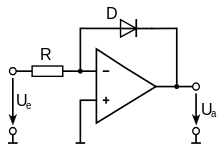
Simplified circuit diagram of a logarithmiser
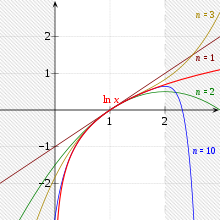
Illustration of the first partial sums of the series representation of the natural logarithm discovered by Nicolaus Mercator; the series converges only in the non-hatched area
Complex logarithm
Analogous to the real definition, each complex number is called 
a natural logarithm of 



is not uniquely determined. Thus, if one has 

with each integer 


To achieve uniqueness, one selects from the possible values for 
use. A value 


with the argument function 







continuous and even holomorphic.
For attention
For the main branch of the complex logarithm 

with
shows that
is not 


is not always fulfilled, as the counterexample
proves.
· Graphical representation of the complex logarithm
· 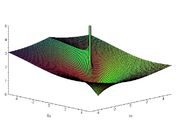
Amount of
· 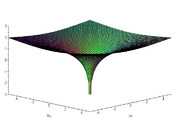
Real part of
· 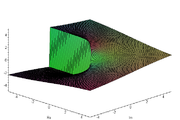
Imaginary part of
With the main branch of the complex logarithm defined above, one can explain the logarithm of negative real numbers:
This requires that the argument function 

These considerations show that the ambiguity of the complex logarithm is ultimately due to the ambiguity of the argument function.
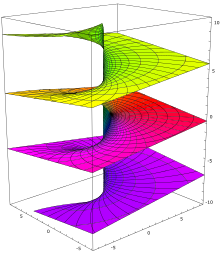
Riemann surface of the complex logarithm function: The leaves reflect the ambiguity of the logarithm, which follows from the periodicity of its inverse function, the exponential function.
Discrete logarithms
→ Main article: Discrete logarithm
Discrete logarithms are solutions of equations of the form
over a finite cyclic group 





Discrete logarithms are complex to calculate for many groups in terms of complexity theory and are used in cryptography, for example in cryptosystems based on elliptic curves.
Example:
has the value 4 as a solution, because 24 = 16 holds, and 16 leaves the remainder 5 when dividing with remainder by 11. The solution is unique modulo 10, i.e. modulo the group order of 


See also
- Exponential function
- Euler's number
- Iterated logarithm
- Logarithmic spiral
- Chain logarithm
- Logarithm paper
- Matrix logarithm
- Generalised logarithm
Questions and Answers
Q: What are logarithms?
A: Logarithms are a part of mathematics related to exponential functions. They tell what exponent is needed to make a certain number, and they are the inverse of exponentiation.
Q: How were logarithms historically used?
A: Logarithms were historically useful in multiplying or dividing large numbers.
Q: What is an example of a logarithm?
A: An example of a logarithm is log₂(8)=3, where the base is 2, the argument is 8 and the answer is 3.
Q: What does this example mean?
A: This example means that two raised to the power of three (2³) equals eight (2x2x2=8).
Q: What are some common types of logarithms?
A: Some common types of logarithms include common logarithms with base 10, binary logarithms with base 2, and natural logarithms with base e ≈ 2.71828.
Search within the encyclopedia





























![{\displaystyle \log _{b}{\sqrt[{n}]{x}}=\log _{b}\left(x^{\frac {1}{n}}\right)={\frac {1}{n}}\log _{b}x.}](https://www.alegsaonline.com/image/67539e2acb1a493452d8ddd9912c8b2631d8b0d2.svg)












![\int_0^1{\ln x\,\mathrm dx} = [x\ln{x}-x]_0^1 = -1,](https://www.alegsaonline.com/image/2e8a29f53f3d2a8eae6731953681efd34f9bcc52.svg)

![{\displaystyle \mathbb {R} ^{+}={\mathopen {]}}0,\infty {\mathclose {[}}}](https://www.alegsaonline.com/image/468db4e96cb23e3d62fc8094c04ab400e4a445a5.svg)













































![{\displaystyle \ln x=\lim _{n\to \infty }n\left({\sqrt[{n}]{x}}-1\right)=\lim _{n\to \infty }n\left(1-{\frac {1}{\sqrt[{n}]{x}}}\right)}](https://www.alegsaonline.com/image/f7901ca277e9fe1a5be535f262d7d4a84fc51a3f.svg)

















